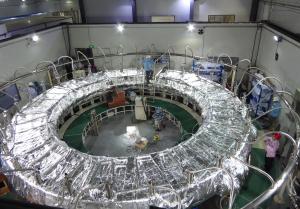Heaviest and first to go
The heaviest of ITER's ring magnets, poloidal field coil #6 (PF6), is taking shape at the Chinese Institute of Plasma Physics ASIPP under the terms of an agreement signed with the procuring party, Europe. Three of the nine spiralled coils of conductor ("double pancakes") required for the final assembly have been wound and one is in the final stages of vacuum impregnation. Nearly 80 people are involved with fabrication.




